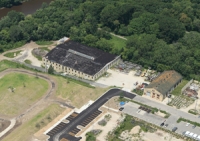
What is Environmentalism? Depends on Who You Ask
I came to the Center two and a half years ago as a summer camp intern. As my role has changed from environmental educator to volunteer coordinator and community health evaluation coordinator, I have found myself reflecting on a question that has repeatedly come up in the various roles I’ve held: What is environmentalism?
It didn’t take long in my role as an educator to notice that how I engaged with nature wasn’t universal. Activities I loved as a child, like catching bugs or sitting quietly in the woods or playing in snow, while appreciated by some, could be terrifying, disgusting or down right boring to some of my students.
New Year, New Land
I knew the call would come eventually, I was just hoping it would take a little longer to happen. When it did come, however, I was incredibly thankful that it left an opening and was not final.
“Ken, we’ve decided that we need to sell the property and have some interested buyers who have offered some very attractive numbers to us,” she said, “however, we’d love it if there was a way for the Center to have it. We cannot give it away but we might be able to give you time. How long do you think you would need to make a run for it?”
A Sense of Tribe
Of all of the things the Native Americans have contributed to society, I think one of the most important is the tribe. Based on kinship, orally communicated customs and rituals and commonly shared values and beliefs, people within the tribes are attuned to others in the group and often work toward shared goals (e.g. food, shelter, healthcare, raising children, etc). They are also each others’ support network. It’s a social construct that has worked for thousands of years.
Washington Park: Ready to Blossom!
Can you believe it’s been only seven years since we hired our first staff member to start up our Washington Park branch? The growth there has been amazing! With the start of a new year, we, like many of you, are reflecting on the past and thinking about our plans for the year ahead. These two perspectives, hindsight and anticipation, seemed like the best way to give an update on our Washington Park branch! Wait, we’re getting ahead of ourselves. It all started with...
Annual Meeting is November 20th!
Join us on November 20, 2013 for our Volunteer Appreciation Party and Annual Meeting, an evening of food and fun as we celebrate our year, share our future plans and thank our wonderful volunteers for the tremendous work they do. Among those volunteers being recognized are members of the Urban Ecology Center Board of Directors. We thank them for the vision and leadership they provide.
The Importance of Your Story
As part of my job I get to meet a lot of really interesting and wonderful people. In fact, that’s one of my favorite parts of this work! For example, I recently got to meet Surhabi Shah, the Director of the US Environmental Protection Agency Urban Water Initiative. She was in Milwaukee and wanted to meet with a few of the folks involved in the work in the Menomonee Valley to learn about what we’re doing to restore that waterway.
The EPA wants to know what we’re doing here? Amazing! But also a little nerve wracking.
Wow! What a Year!
Autumn is when nature provides us with a reminder of change: leaves become vibrant, the sun sets early and morning frost is on windows. It is also the season when we at the Urban Ecology Center reflect on our year and the changes we made as an organization. Our fiscal year begins in September in order to include an entire school year, so fall is the time when we’re getting ready for a “new year.”
Together, We are an Ocean
“Individually, we are one drop. Together, we are an ocean.” — Ryunosuke Satoro.
I love the community we’ve built at the Urban Ecology Center! I am constantly amazed by the dedicated and passionate people I meet here. Here are four affirming vignettes – all from one day!
First I had a meeting at Menomonee Valley:
Celebrate Menomonee Valley's First Year
Our Menomonee Valley branch is one year old – time to celebrate! Join us on Saturday, September 7th as we take a look back at our past year and explore Three Bridges Park!
It's been a busy and exciting first year that included school programs, summer camps and the opening of Milwaukee's newest park! We thought it be fun to take a look at our past year and share some of our favorite memories. Check back as we will be updating this page until Saturday's celebration!
Explore and Restore Milwaukee’s Magnificent Waters
Throughout history Milwaukee’s rivers have tremendously affected the people of this area. People have relied on these now-urban waterways for food, travel, trade, industry and recreation. But just as Milwaukee’s Magnificent Waters have affected us, our actions and behavior affect the rivers we love and rely on. In 1987, the Milwaukee Estuary was designated an Area of Concern (AOC) by the federal government. The waters of the Estuary are considered impaired as the result of historical modifications like dredging and straightening, and heavy pollutant loads. It is one of forty-three AOC-designated Great Lake watersheds in the U.S. and Canada.
Copyright © 2023 The Urban Ecology Center












